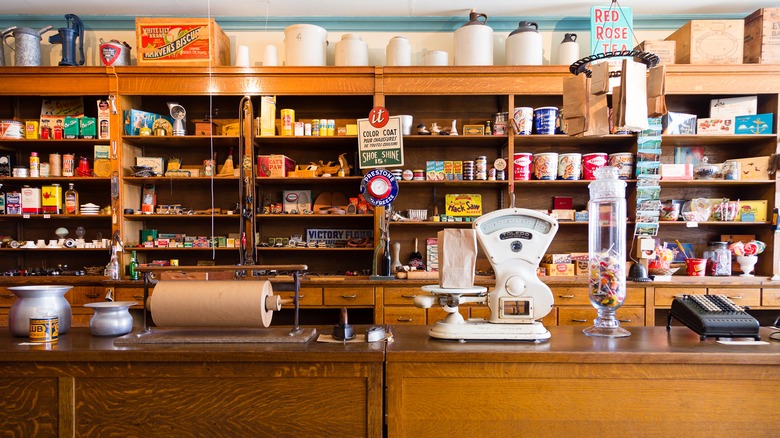How Shopping At A General Store Was Different From Modern Supermarkets
General stores are a well-known piece of North American history. They're part of the image that comes to mind when we think of pioneers and traditional small-town life. But what was it actually like to shop in a general store?
Living History of Illinois states that, unlike the well-lit, carefully arranged grocery stores that we know today, general stores were typically dimly-lit place that were overpacked with goods. By today's standards, they weren't particularly sanitary since stores were heated by smoky cast-iron stoves in the winter and customers tracked in dirt and animal waste.
According to The Henry Ford, sugar was the most popular good sold at general stores in the 1880s. Without modern refrigeration, many people relied on canning to preserve food for the winter. Tea and canned goods were other popular items, though some people were critical of those who purchased canned goods instead of preserving food at home.
In addition to food, general stores were stocked with dubiously medicinal treatments as well as dry goods and other needed items, including cooking utensils, sewing supplies, guns, and sometimes even coffins.
Canada's History writes that general stores weren't just a place to buy food and household goods. They also served as places for people to gather together as a community. Since store owners often kept large amounts of money on hand, they sometimes served as unofficial bankers and lent money to customers. When money was scarce, many store owners were willing to barter for goods and services.
Piggly Wiggly changed the grocery store game
Smithsonian Magazine writes that in 1916, Clarence Saunders opened Piggly Wiggly in Memphis, Tenn., which is considered the first "self-service" grocery store. While general stores would have a clerk select your items for you, Piggly Wiggly employees were just there to stock shelves and point customers in the right direction. While this cut costs, it was a radical move for the time. To bring customers to the store, Saunders hired a brass band for the grand opening and hosted a "beauty contest" where every woman who entered the store was deemed a "winner" and handed a gold coin (per Tennessee Historical Quarterly).
According to Time, Saunders also pioneered ideas like arranging the store to appeal to the way that customers shopped. He placed candy bars near the checkout for impulse buyers while also putting store employees in uniform.
In the 1940s, many general stores were forced to close when their employees went to war. Larger grocery stores took their place. By the 1950s, grocery stores had become an American success story. In 1957, when Queen Elizabeth visited the United States, she went to a supermarket (per Time). The Queen was reportedly charmed by the fold-down seats for children in shopping carts.
While modern shoppers can easily buy goods online, physical grocery stores are still popular and will likely be a part of our communities for a long time.

